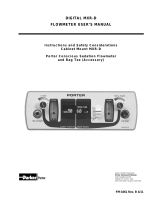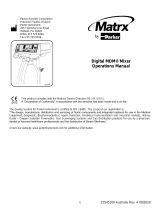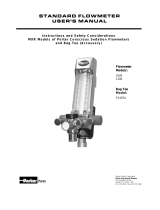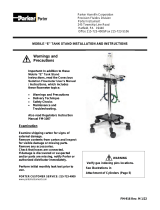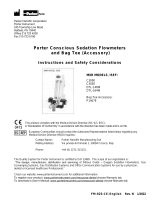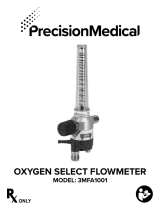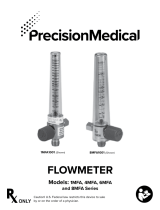Page is loading ...

FM-1286
12/13/2013
Parker Hannifin Corporation
Porter Instrument Division
245 Township Line Road
Hatfield, PA 19440
Office 215 723 4000
Fax 215 723 5106
PORTER DIGITAL MDM
Operations and Installation
Manual
The Quality System for Porter Instrument is certified to ISO 13485. The scope of our registration is:
“The design, manufacture, distribution and servicing of Nitrous Oxide – Oxygen Sedation Flowmeters, Gas
Scavenging Systems, Gas Distribution Systems and Office Communication Systems for use by a physician, dentist or
licensed healthcare Profession.”
Check our website: www.porterinstrument.com for additional information.
To register your product: www.porterinstrument.com/resources-dental choose Warranty tab.
To download a User’s Manual: www.porterinstrument.com/resources-dental choose Manuals tab

2
IMPORTANT:
READ MANUAL COMPLETELY Before Operating This Device
Basic delivery technique is described. Also, this manual contains instructions on periodically required checks to be
performed by the user. These checks are necessary to insure the proper performance of this device and its safety
features. Retain this manual for future reference.
WARNINGS AND PRECAUTIONS
These warnings and precautions are to help you to
understand how to safely operate the PORTER Digital
MDM Flowmeter. A WARNING alerts you to a
possible hazard to people. A CAUTION alerts you to
the possibility of equipment damage.
WARNING: Do not use this device for the
administration of general anesthesia or as a part of, or
in conjunction with, a general anesthesia
administration system.
WARNING: Workers are exposed to N2O during
administration of N2O/O2 conscious sedation
analgesia. NIOSH has recommended that exposures
should be minimized. Contact NIOSH (1-800-35-
NIOSH) to receive NIOSH Publications on Control of
Nitrous Oxide in Dental Operatories. Exposure can be
minimized by effective controls. National Institute for
Occupational Safety and Health (NIOSH) publications
state that controls, including System Maintenance,
Ventilation and Work Practices can effectively reduce
N2O concentrations in patient procedures. Your
flowmeter accessory Porter scavenger system is an
important part of the system of controls.
WARNING: Porter Instrument equipment utilizes the
cross+protection system. The flexible hose and
connectors that connect to the flowmeter are diameter
indexed; 3/8” O.D. for Nitrous Oxide and ½” for
Oxygen. The cross+protection system is designed to
prevent misconnection of Oxygen and Nitrous Oxide
piping. DO NOT ATTEMPT TO CHANGE THE
DIAMETERS OR CONNECTORS OF THE
FLOWMETER! Tampering with the cross+protection
system constitutes acceptance of liability by the
installer. For your own protection, as well as that of the
Doctor and the patients, use 3/8” O.D. tubing for all
Nitrous Oxide lines and ½” O.D. tubing for all Oxygen
lines.
To assure safe operation and conformation to local fire
codes, all Porter Instrument flowmeter systems are
designed to be used with sedation delivery systems
mounted inside walls and they meet or exceed the
guidelines established by the National Fire Protection
Association for Nonflammable Medical Gas Systems,
NFPA 99. Copies of NFPA 99 or portions thereof may
be obtained by writing to: National Fire Protection
Association, Batterymarch Park, Quincy, MA 02269-
9904; or call 1-800-344-3555
WARNING: New or modified installations - properly
connected gas pipelines are absolutely essential
to patient safety. The authorized distributor or
contractor should provide written documentation that
all gas pipelines are connected properly and that the
system has been pressure tested prior to use. While
this is a good business practice, it is important that the
user verify by their own test, independent of the
authorized distributor or contractor, that all gas
pipelines are connected correctly prior to using the
system. The ultimate responsibility of assuring
that lines are not crossed rests with the user.
WARNING: During any power outage, remember to
turn OFF the flowmeter and manually turn OFF the
tank valves. With centralized, electrically powered
gas systems, if gas was flowing when the power went
out and the flowmeter is left ON, gas will be flowing
when the power is restored.
CAUTION: This device is for use by or on the order of
a physician, dentist or licensed healthcare
professional.
CAUTION: Always use clean, dry medical grade
gases. Introduction of moisture or other contaminants
into this device may result in defective operation.
CAUTION: Do not attempt to repair, alter or calibrate
this device. Unauthorized repair, alteration or misuse
of this device is likely to adversely affect the
performance and will void the warranty.
CAUTION: Never oil or grease any part of this
system (minimize fire or explosion potential).

3
Symbol Description
MEDICAL EQUIPMENT WITH
RESPECT TO ELECTRIC
SHOCK, FIRE AND
MECHANICAL HAZARDS IN
ACCORDANCE WITH UL 2601-1,
AND CAN/CSA C22.2 NO. 601.1
Alternating Current
Protective Earth (ground)
Attention, consult the accompanying documents
WARNINGS and PRECAUTIONS
ELECTRICAL CONNECTIONS & GROUNDING INSTRUCTIONS
The unit must be grounded. If it should malfunction or breakdown, grounding provides a path of
least resistance for electrical current to reduce the risk of electric shock.
A known Protective Earth (ground) connection must be made via one of the following methods:
1) The third wire on the power cord when plugged into an appropriate outlet that is properly installed and
grounded in accordance with all local codes or ordinances.
2) The external ground lug on the rear of the device.
A Protective Earth (ground) connection is a connection attached to the facility grounding point outside the facility.
A licensed electrical person should be consulted to confirm the Protective Earth (ground) connection.
Do not use an electrical cord with nicks, cuts, or other damage. Do not use the unit with an
extension cord as it will be subject to electromagnetic interference (EMI).

4
REQUIREMENTS AND FEATURES
BAG TEE REQUIREMENTS
A bag tee containing an air inlet valve is required for use with this unit. The bag tee is provided separately for
remote mounting. Porter Scavenging Nasal Inhalers provide the patient connection.
FACILITY PIPING
The user MUST perform tests independent of the dealer or contractor to verify that all pipelines are connected
correctly. If you are unfamiliar with piping systems, consult NFPA-99 Health Care Facility piping guidelines. The
user has the ultimate responsibility for properly connected pipelines essential to patient safety.
DIAMETER INDEXED SAFETY SYSTEM
Gas connections in the DIGITAL MDM mixer are mechanically indexed using the Diameter Indexed Safety
System (DISS). This feature helps to prevent the crossing of pipelines. Under no circumstances should these
connections be altered.
DISCONNECT POWER
There are no user-serviceable parts inside this unit. A shock hazard exists if power is not
disconnected prior to any internal servicing or maintenance. Always disconnect the power
source before inspection or repair.
SAFETY ALARM SYSTEM TEST
The user should test the alarm system for proper operation prior to each clinical use.
INTENDED USE: FLOWMETER FOR ANALGESIA DELIVERY SYSTEM
This device is intended for patient use by an attending physician, dentist or licensed professional properly trained
in its use. Porter Instrument recommends the user be thoroughly familiar with the use of Nitrous Oxide - Oxygen
Conscious Sedation for patient analgesia and be properly trained in its administration prior to using this product.
For training requirements on the administration of Nitrous Oxide - Oxygen Conscious Sedation, contact the
appropriate regulatory authority in your country, state, or province. Training is recommended to provide a
practical, hands-on capability and an understanding of the behavioral aspects of Nitrous Oxide Sedation and will
complement the safety features of this device. The devices permit the operator to adjust the percent of oxygen
through a range of 100% to 30% (and thereby control the ratio of oxygen to nitrous oxide). The operator can also
control the total volume of mixed gas up to 9.9 liters per minute.
Use Scavenging
Monitor for N2O in the patient treatment area to insure that controls are effective in achieving low levels of PPM
(parts per million) exposure. Contact your Porter dealer for details on monitors and testing.
Gas Supply Connection
After installation of the flowmeter, connect the nitrous oxide and oxide supply lines to the Diameter Indexed Safety
System (DISS) fittings located on the back of the flowmeter base unit. It is important that the regulators for both
gases be set to give pressures in the range of 50 PSIG to 55 PSIG. Confirm the absence of leaks at pressure
connections on the base unit. Bubbles will appear at leaking locations when a soap / water solution is used.
User Responsibility
This product should not be repaired other than in accordance with written instructions provided by Porter. The
user of this product shall have the sole responsibility for any malfunction which results from improper use, faulty
maintenance, improper repair, damage, or alteration by anyone other than Porter. It is the user’s responsibility to
ensure that the correct gas, at the correct pressure, is supplied to the fittings at the rear of the base unit.
Machine Diagnostics
The DIGITAL MDM mixer performs self checks at start up and during operation. If any errors are detected, the
unit displays EE on the %O2 display and an error code on the FLOW display. If an error code appears, remove

5
the unit from patient service and call the Porter Technical Service Department at 1-888-723-4001. To aid in the
diagnostics of the unit, make note of the final error code displayed.
Description of Unit: The DIGITAL MDM mixer consists of a Control Unit attached to a Base Unit via an
Interface cable. Note - Control and Base Units are calibrated together and must remain together (match
serial numbers on each unit). Only use Porter Interface cable (EMI protection). The Control Unit interface is
shown in Figure 1. The device permits the operator to adjust the percent of oxygen through a range of 100% to
30% (and thereby control the ratio of oxygen to nitrous oxide). The operator can also control the total volume of
mixed gas up to 9.9 liters per minute.
Mixture Control: The DIGITAL MDM mixer precisely mixes oxygen and nitrous oxide from local cylinders or
pipeline gas systems, and delivers the electronically controlled mixture to the bag tee outlet.
Built-In Safety: A series of alarms (see Safety Alarm System page 6) alert the user to any problem condition
within the DIGITAL MDM mixer unit or in the gas supply.
Displays and Indicators: In the following, the location numbers refer to Figure 1.
Flow Display: The LPM FLOW display (4) normally displays the total gas flow rate. It also displays the individual
nitrous oxide or oxygen flow rates when either the N2O or O2 flow display controls (6) are pressed. The gas flow
being displayed is indicated in the flow indicator (5) by O2, TOTAL or N2O.
% OXYGEN Display: The % OXYGEN display (3) indicates the oxygen concentration set point in the total flow.
Gas Flow Indicators: Gas flow is indicated by bar graph LEDs (1). A green bar graph represents O2 while blue
represents the N2O flow. The number of lit bars gives a graphical indication of the flow level of a particular gas.
Figure 1. PORTER DIGITAL MDM Mixer Control Unit Front Panel
(figure shows all LEDs illuminated)

6
SAFETY ALARM SYSTEM
There are four alarm conditions on the DIGITAL MDM
mixer. They appear in the safety alarm display (see
Figure 1, item 2) only when conditions warrant.
Otherwise, they are not visible. The alarm conditions
are:
OXYGEN FAILURE: This alarm indicates that the set
oxygen (O2) flow cannot be delivered. Check the
oxygen supply. During an OXYGEN FAILURE alarm,
the nitrous oxide delivery is automatically shut off. The
LPM FLOW and % OXYGEN displays are off.
NITROUS FAILURE: This alarm indicates that the set
nitrous oxide (N2O) flow cannot be delivered. Check
the nitrous oxide supply. During a NITROUS FAILURE
alarm, the LPM FLOW display indicates oxygen flow
and the % OXYGEN display is off.
Both the OXYGEN FAILURE and NITROUS FAILURE
are self-canceling alarms. When the gas is restored,
the unit returns to the flow rate and mixture ratio which
were in effect before the alarm condition.
1 LPM OXYGEN LIMIT: This message is displayed
when the oxygen flow rate reaches a value of 1 LPM
(liter per minute); the unit will not allow the oxygen flow
rate to go below this value. If the user attempts to
lower the % OXYGEN while this message is displayed,
the unit compensates by increasing the total flow rate.
FLUSH FLOW LOW: This message indicates that the
oxygen flush flow rate is less than 10 LPM. Check the
oxygen supply pressure.
KEY PAD CONTROLS
CAUTION: Operate key pad with finger pressure
only. Do not use hard or sharp objects. Failure to
do so may result in DAMAGE to front panel.
On/Off Key: The ON/OFF key controls the operation
of the unit. Momentarily depressing the ON/OFF key
changes power state from OFF to ON or ON to OFF.
Note: If the power to the unit is interrupted and then
restored, either by disconnecting / reconnecting the
power cord or by local power failure, the unit will
display OFF. The operator must press the ON/OFF key
to restart the unit. The unit will then display default
values of 100% oxygen at 5 LPM.
CAUTION: After turning the device off, or when the
unit is not in use, all oxygen and nitrous oxide
supply cylinder valves must be closed.
Flow Control: The LPM FLOW key pad [ or ]
controls the total flow rate delivered by the unit.
Pressing the appropriate key momentarily increases or
decreases the total flow rate by 0.1 LPM. By pressing
and holding a key, the total flow rate indication
changes slowly for the first two steps, then changes at
a faster rate for the remainder of the time the key is
held. An audible signal indicates that a limit has been
reached.
%O2 Control: The % OXYGEN key pad [ or ]
controls the percentage of oxygen delivered by the
unit. Press the appropriate key momentarily to increase
or decrease the oxygen percentage one step (1% or
5%). Pressing and holding the key changes the oxygen
percentage slowly for the first two steps, then faster for
the remainder of the time the key is held. This varies
the ratio of oxygen to nitrous oxide. An audible signal
indicates that a limit has been reached.
Setting % OXYGEN Step Amount (1% or 5%):
The DIGITAL MDM mixer is shipped from the factory
programmed to change 1% for each press of the %
OXYGEN key pad [ or ]. The amount can be
changed from 1% to 5% by using the DISPLAY N2O
and DISPLAY O2 keys and the following procedure:
1. Press and hold the DISPLAY N2O key.
2. While pressing the DISPLAY N2O key, press the
DISPLAY O2 key until the audible alarm sounds.
3. Release both keys.
The audible signal indicates the change has occurred
and is programmed in memory. The unit will remain in
the new mode until this sequence is repeated.
Unplugging or turning the unit off will not affect the
programmed mode.

7
Flow Display Control: The key pad DISPLAY O2 or
DISPLAY N2O select the gas flow rate displayed on the
flow display. Press and hold the DISPLAY N2O key to
display the nitrous oxide component of the total flow.
Press and hold the DISPLAY O2 key to display the
oxygen component of the total flow. If neither key is
held, the LPM FLOW display indicates the total gas
flow.
Oxygen Flush Key: Pushing the O2 FLUSH key
delivers 100% oxygen directly to the mixed gas outlet
at the rear of the unit. This outlet is connected to the
patient through the breathing tube connector (see
Figure 2). While the key is pushed, 100% oxygen is
delivered continuously at a minimum flow rate of 20
LPM. Releasing the key returns the unit to the flow rate
and mixture ratio which were in effect prior to the flush.
Alarm Test/Silence Key: The alarm test / silence
key serves two functions. When pressed, all the
display, indicators and the audible alarm turns ON.
This key also silences the audible alarm when a
NITROUS FAILURE condition exists. The audible
alarm will be silent for about five minutes and then
resume, unless the failure condition has been
corrected.
Machine Diagnostics
The DIGITAL MDM mixer performs self checks at start
up and during operation. If any errors are detected, the
unit displays EE on the % OXYGEN display and an
error code on the LPM FLOW display. If an error code
appears, remove the unit from patient service and call
the Porter Technical Service Department at 1-888-723-
4001.
To aid in the diagnostics of the unit, make note of the
final error code displayed.

8
PORTER DIGITAL MDM SYSTEM ILLUSTRATION

9
PORTER DIGITAL MDM SYSTEM COMPONENTS & ACCESSORIES
Item
No. Part Number Description
1 40152601 PORTER DIGITAL MDM
2 AVS-5000 AVS optional
3 5501-RK Vacuum Block Kit optional
4 5155-1 Adult Rubber Gds (w/ Vacuum Block)
4 5155-3 Adult Rubber Gds (no Vacuum Block)
5 P1407A Bag Tee
6 4100 3L Bag
7 A-2633-000 Adapter for Bag Tee
8 A-1679 Remote Bag Tee Adapter
9 B-2460-001 O2 Check Valve
9A B-2461-001 N2O Check Valve
10 8005 O2 Hose, Diss / Diss, 5 Ft
10A 8505 N2O Hose, Diss / Diss, 5 Ft
10B 80012 O2 Hose, Diss / Diss, 12 Ft
10C 85012 N2O Hose, Diss / Diss, 12 Ft
11 PA-450-1-002 O2 Hose, 12 Ft
11A PA-450-1-001 O2 Hose, 20 Ft
12 A-2508-000 Kit, Rubber Gds Hook
- B-5555-000 Kit, Recessed Face Mount
- B-5555-001 Kit, Under Cabinet Mount
- B-5555-002 Kit, “Z” Brackets, Under Cabinet Base Unit Mount
(optional)
- B-5485 Bracket, Face Mount
Mounting Options for Bag Tee and AVS
13 2036-4 3 1/2" Wide Slide (not shown)
14 2036-2 5" Wide Slide (not shown)
15 2037-1 7" Wide Under Cabinet Mt (not shown)

10
GENERAL INSTALLATION
Installation
1. Using the available brackets mount the
Remote Interface Control Unit as desired
(see Figure 2.) Shown for recessed into wall.
(Kit B-5555-000)
Figure 2. Control Unit recessed mount.
2. For mounting on to wall (see Figure 3), first
remove side screws to separate back bracket
from Control Unit. Mount back bracket to wall.
Slide Control Unit on to back bracket and
install and tighten side screws again.
(Bracket B-5485)
Figure 3. Control Unit mount directly to wall.
3. Use bracket shown in Figure 4 for under
cabinet mounting. Turn same bracket
upside-down (not shown) for table-top mount.
(Kit B-5555-001)
Figure 4. Control Unit under cabinet mount.
4. Typically mount the Base Unit in a horizontal
orientation (Figure 5). Using same mounting
plate, may also be mounted vertically up,
down, or side. Do not mount Base Unit
upside-down. Adding “Z” brackets allows for
mounting Base Unit horizontally, but in an
under cabinet orientation. (Kit B-5555-002,
“Z” bracket)
Figure 5. Porter Digital MDM connected with
interface cable.
Control Unit

11
5. Attach one end of the Interface Cable to the
Base Unit and the other end to the Control
Unit. Note - Be sure to use the Porter
cable that came with the unit and that the
cable connector is screwed in at each
end. (see Figure 5.)
6. Install the Remote Surface Bag Tee mount.
Installation of Rubber Goods
Refer to FM-809 for installation of Rubber Goods.
Installation of Power Cord
Insert the power cord into the input connector on
the rear of the unit (see Figure 7).
WARNING
For safety a Protective Earth (ground) connection
must be made through power cord 3rd wire or
Ground Lug (see Figure 7).
WARNING
Not providing a valid Protective Earth (ground)
connection can result in the risk of electric shock.
Connection of Oxygen – Nitrous Oxide
For safety reasons, gas connections are color-
coded and mechanically indexed using the
Diameter Indexed Safety System (DISS) to
prevent accidental cross connection. DISS
female hexagon fittings are standard for both
hoses.
1. Connect the DISS female hexagon fitting of
the nitrous oxide hose to the male DISS, N2O
INLET, fitting on the back of the mixer head
(see Figure 6). Hand-tighten and then finish
tightening with a 7/8” inch open end wrench
(approximately 1/8 turn). Do not over-tighten.
2. Connect the DISS female hexagon fitting of
the oxygen hose to the male DISS, O2
INLET, fitting on the rear of the unit (see
Figure 6). Hand-tighten and then finish
tightening with a 11/16” inch open end
wrench (approximately 1/8 turn). Do not over-
tighten.
Hoses
Hoses are manufactured for connection to the
gas source in various configurations:
- Quick Connect fittings are designed for rapid
“no tool” connections with corresponding
male / female fittings or outlet stations. Refer
to the individual manufacturer’s instructions
for specific connection procedure.
- DISS to DISS hoses are designed primarily
for portable systems. The gas source (male)
DISS fittings are located on the regulators on
the cylinder mount block provided with the
portable units. Connect the DIGITAL MDM®
mixer to the cylinder mount block using the
appropriate nitrous oxide hose and the
oxygen hose.
Demand Valve Resuscitator
An optional Demand Valve Resuscitator for
emergency oxygen resuscitation is available from
Porter (PN 1506-1) and connects directly to the
O2 outlet (Figure 6) on the rear of the unit.

12
Figure 6. Connection to the back of unit.
Figure 7 Installation of Power Cord.
Figure 8. Connections Schematic
(some components may not be part of your installation).
Power
Cord
N2O DISS
O2 DISS

13
FLOWMETER ACCESSORIES
Three or Two Liter Reservoir Bag
Install the reservoir bag by sliding the opening over the outside of the bag tee downspout. The bag
moves in and out with each inhalation and exhalation and becomes a visual barometer for monitoring the
patient’s respiration rate. Refer to FM-809 for User Instructions, Assembly, Installation and Cleaning.
Gas Scavenger Breathing Circuit
Gas scavenger system is used to remove exhaled gases during a dental analgesia conscious sedation
procedure in a dental operatory. The breathing circuit consists of a 22mm 90° elbow connector, fresh gas
/ coaxial tubing, a corrugated hose and hood assembly. Attach the nasal inhaler to the coaxial tubing
assembly using the diameter-indexed connectors. Attach one end of the fresh gas corrugated tubing to
the coaxial tubing assembly at the fresh gas “Y” connector and the other end to the 22mm right angle
adapter. Press fit the 22mm right angle adapter onto the bag tee. Attach a 2L or 3L reservoir bag to the
bottom / downspout of the bag tee. Attach the vacuum hoses to the vacuum control source (AVS or In-
line Vacuum Control Block). Refer to FM-809 for User Instructions, Assembly, Installation and Cleaning.
Figure 9. 5061 Connector Installation
Gas Scavenger Breathing Circuit (with AVS)
The AVS is used to control the vacuum flow in the gas scavenger breathing circuit and assure that the
scavenging system is activated as soon as N2O / O2 is turned ON. Adjust the vacuum flow using the
control knob. Vacuum flow is most effective when the ball float is set within the green bar area.
Installation of AVS to Flowmeter: Screw AVS 5000 knurled seal nut down tight onto flowmeter making
sure the rubber washer is inside the seal nut. When tight, the AVS should not rotate. Then, screw the
bag tee seal nut onto the AVS. Bag tee should not rotate. Connecting AVS to Vacuum Hoses: Attach
one end of the vacuum hose to the vacuum hose “Y” connector and the other end to the MASK port of the
AVS. Attach a second vacuum hose to the VAC port of the AVS and the other end to the vacuum source.
Refer to FM-809 for User Instructions, Assembly, Installation and Cleaning.
5061 Connector Installation

14
Porter recommends that effective scavenging can be achieved with the ball float in the green bar area of
the acrylic sight glass, however NIOSH publications conclude that higher vacuum flows of up to 45 L/min
are most effective. To meet the NIOSH recommendation of 45 L/min adjust the ball above the green bar
area.
CAUTION: DO NOT PROCESS ANY LIQUIDS OR DEBRIS THROUGH THE AVS.
This contamination can cause damage and affect the function of the unit. The AVS is designed to regulate
the vacuum flow level for scavenging of Nitrous Oxide / Oxygen gas only.
CAUTION: The vacuum system should be equipped with a back flow shutoff device to prevent
carryover of fluids into equipment attached to the piping systems. It is recommended that a separate
vacuum trap be used between the piping system and the vacuum station inlet or any equipment that is
attached to the system.
In-line Vacuum Control Kit (Option)
The kit includes a vacuum control block with sight glass, vacuum tube holder, adapter “T” and straight
fitting. The vacuum control block can be inserted directly into the High Volume Evacuation (HVE) line or
may be placed “in-line” by cutting the vacuum hose and attaching the cut ends of the tubing to both ends
of the vacuum control block. Adjust the vacuum flow using the control knob. Vacuum flow is most
effective when the ball float is set within the green bar area. Refer to FM-809 for User Instructions,
Assembly, Installation and Cleaning.
Bag Tee
The Bag Tee assembly features a Non-rebreathing Valve and an Emergency Air Intake located on the
Bag Tee, which comply with American Dental Association guidelines. The non-rebreathing valve has a
back flow check valve, which prevents exhaled gases from entering the breathing bag (no carbon dioxide
buildup). The emergency air intake has a valve that allows room air to be inhaled into the breathing
circuit by the patient. A breathing bag is attached to the metal portion of the Bag Tee and is a reservoir
bag for the delivered analgesia gases, which when taken together with the two valves above, becomes
the visual barometer for monitoring the patient’s respiration rate. The bag moves in and out with each
inhalation and exhalation.
Bag Tee Installation to Flowmeter: Screw knurled seal down tight onto flowmeter making sure the rubber
washer is inside the seal nut. When tight, the bag tee should not rotate.
Note: Fit mask to patient so inner mask is pulled down tight secure to the face. Outer mask should not
be against the face. Vacuum needs to be drawn into outer mask during inhalation.

15
ACCESSORY MONTHLY CHECKS
Non-Rebreathing Valve - Check Monthly
Place the On / Standby switch in the STANDBY (Off) position. Disconnect the corrugated rubber tubing
from the Rubber Goods and breathe into the corrugated tubing connected to the bag tee. You should not
be able to fill the bag with exhalation gas. If the bag fills, the system’s Non-Rebreathing Valve (See Fig.
10 below) is not functioning properly and should be replaced.
Figure 10
Emergency Air Valve - Check Monthly
Place the On / Standby switch in the STANDBY (Off) position. Disconnect the corrugated rubber tubing
from the gas scavenging apparatus and draw air with your mouth through the corrugated tubing
connected to the bag tee. With gas bag fully collapsed, you should be able to draw ambient air through
the Emergency Air Valve (See Fig. 10 above). Air going through the valve sounds different than normal
gas flow.
Emergency
Air
Intake
Non-Rebreathing
Valve

16
SIDE EFFECTS & CONTRAINDICATIONS
Note: This is not an exhaustive list. The list was prepared from published articles.
Possible Side Effects of Nitrous Oxide – Oxygen Conscious Sedation: May experience
nausea, vomiting, excessive sweating, euphoria, excitement, deep sedation, drowsiness, sleep,
dizziness, lightheadedness, dysphoria, amnesia, and headaches.
Precautions and Contraindications for Nitrous Oxide Use
Precautions/Relative Contraindications
Discontinue the Nitrous Oxide delivery if observed: prolonged inspirations,
irregular breathing, involuntary eye movements, swallowing or gagging, dilated
pupils and rigid muscles.”
Side effects (e.g., nausea, vomiting, dizziness, dysphoria, etc.) are not tolerable.
Current vitamin B12 deficiency.
Bronchoconstrictive disease (asthma) – (at determination of medical
professional).
The use with pediatric patients, especially age 1 to 4 years, requires caution and
specific protocols developed by the medical professional; upper age limit at
determination of medical professional. Weight limitations at the determination of
medical professional.
Contraindications
Inability to hold own face mask, impaired oxygenation, or hemodynamic
instability
Acute drug or alcohol intoxication or impaired consciousness (head injury,
endocrine or metabolic disease, patients taking antidepressant or psychotropic
drugs), psychologic impairment, patient who has taken medication to induce
sleep.
Decompression injuries, increased intracranial pressure, increased intraocular
pressure, intraocular surgery, bowel obstruction, middle ear surgery,
emphysema, pulmonary hypertension and others
Current upper respiratory tract infection, chronic obstructive pulmonary disease
(COPD), cystic fibrosis, shock, acute pulmonary edema (APE), pneumothorax,
and major chest or maxillofacial trauma, bleomycin therapy, recent
pneumoencephalography
Pregnancy (first trimester) – patient may wish to contact OBGYN / medical
professional

17
PREPARATION FOR USE: TESTS, TECHNIQUES, MAINTENANCE
CAUTION: Before using the DIGITAL MDM mixer, check the operation of the unit by performing
the following tests.
Performance Checks: These preliminary tests must be conducted to ensure that your analgesia mixer is
performing correctly. If the unit fails any one of the following performance checks, the unit must be
returned for service.
Machine Turn-On Test:
Press the ON/OFF key, as shown in Figure 1.
After the device goes through an initialization
routine, the % OXYGEN and LPM FLOW displays
should indicate 100% and 5 LPM.
Alarm Indicator / Lamp Test:
Press the alarm test / silence key, as shown in
Figure 1, and observe that all the alarm readouts
illuminate. The % OXYGEN and LPM FLOW
displays should show 8.8.8. and 8.8 respectively.
The alarm readouts should illuminate with the
numerical displays. 10 bars on each gas should
illuminate. The audible alarm should also sound.
Oxygen Failure Test:
Set the LPM FLOW display to 9.9 LPM. Set the %
OXYGEN display to 50%. Turn off the oxygen gas
supply to the unit. When the gas runs out, check
for each of the following:
- the OXYGEN FAILURE alarm illuminates
- the audible alarm sounds
- the flow indicators are off
- the LPM FLOW and % OXYGEN displays are
off
- the N2O gas flow indicator shows no bars
Turn on the oxygen gas supply, and the unit
should return to normal operation. (The alarm may
continue to chime for up to 20 seconds after
restoration of gas pressure.)
Nitrous Failure Test:
Set the LPM FLOW display to 9.9 LPM. Set the %
OXYGEN display to 30%. Turn off the nitrous
oxide gas supply to the unit. When the gas runs
out, make sure each of the following occurs:
- the NITROUS FAILURE alarm illuminates
- the audible alarm sounds
- the LPM FLOW display indicates the oxygen
flow being delivered
- the % OXYGEN display is OFF
- the N2O gas flow indicator is OFF
- the O2 gas flow indicator shows at least 3 bars
Turn on the nitrous oxide gas supply. The unit
should return to normal operation. (The alarm may
continue to chime for up to 20 seconds after
restoration of gas pressure.)

18
Indicated Flow Delivery Test:
Set the % OXYGEN display to 100%. Press the
[] flow key and hold, as shown in Figure 1. The
flow rate should decrease to 1.0 LPM. An audible
alarm sounds at the lower limit while the key is
held. Press the [] flow key and hold. The flow
rate should increase to 9.9 LPM. An audible alarm
will sound at the upper limit as long as the key is
held.
Indicated Percentage (%) Delivery Test:
Set the LPM FLOW display to 9.9 LPM. Press and
hold the [] % OXYGEN key. The % OXYGEN
display should decrease to 30%. The audible
alarm sounds at the lower limit while the key is
held. Press and hold the [] % OXYGEN key, as
shown in Figure 1. The % OXYGEN display
should increase to 100%. An audible alarm
sounds at the upper limit while the key is held.
Basic Delivery Technique:
Practice titration. Titration is a method of
administering a substance by adding definitive
amounts of a drug until an endpoint is reached.
For nitrous oxide / oxygen (N2O) / O2) sedation,
N2O is given in incremental doses until a patient
has reached a comfortable relaxed state of
sedation. The ability to titrate N2O is a significant
advantage because it limits the amount of drug to
that which is required by the patient. If titration is
done properly, the patient does not receive any
more of the drug than is necessary. The amount
of N2O required by a patient on any given day or
time varies.
For information on titration, a most valuable
resource for the practitioner is the Handbook of
Nitrous Oxide and Oxygen Sedation, written by
Clark and Brunswick and published by Mosby
(www.mosby.com). This text is a concise and
contemporary guide for nitrous oxide / oxygen
administration.
Maintenance
The DIGITAL MDM mixer is a precision analgesia
mixing unit. As with any medical instrument, it
requires periodic inspection and maintenance.
The following routine maintenance procedures
should be performed to ensure system integrity
and trouble-free service.
-Inspect mixer, hoses, and connections daily for
damage, wear, and leaks.
-Perform functional tests prior to each use. These
tests are described in Performance Checks,
-While cleaning the outside of the unit, observe
caution so that liquid does not get inside. Porter
recommends using a damp (wrung toward dry)
cloth moistened with a mild soap or a plastic-safe
cleaner. Do not spray directly on the case. A hard
surface disinfectant may be applied in the same
manner. CAUTION: DO NOT submerge the
unit—use a damp cloth.
WARNING: Before cleaning the unit,
disconnect the DIGITAL MDM mixer’s power
cord from the electrical power supply.
Fuse Replacement in Domestic, 115-120V
and International, 220-240V
1. To replace a blown fuse, turn the unit OFF,
disconnect power to the unit by unplugging
the power cord from the wall, and then
remove the power cord from the input
connector on the rear of the unit.
2. Open the fuse compartment, as shown in
Figure 11.
3. Remove each blown fuse from its clip and
replace it with a 5mm x 20mm cartridge fuse,
rated 2.5 amp, 250 volt, slo-blo (time delay),
part number 63882537. Two fuses are
required for the unit to operate.
Figure 11 Fuse Replacement

SPECIFICATIONS
Base Unit Physical
Dimensions: 10” W x 5.5” H x 14” D with hoses and
interface cable connected
Weight: 6 lbs.
Control Unit Physical
Dimensions: 3.5” H x 9.5” W x 1.5” D
Fittings
Mixed Gas Outlet: ¼” Hose Barb
Bag Tee Outlet: 22mm OD
Nitrous Oxide Inlet: Male DISS CGA 1040
Oxygen Inlet: Male DISS CGA 1240
Environmental
Storage Temperature: -l0°F to 120°F
(-l7°C to 48°C) (Allow to stabilize to room temperature
before operating.)
Operating Temperature: 72°F nominal (22°C)
Humidity: Ambient, non-condensing
Gas Supply
Oxygen Inlet
Pressure Requirements: 50 to 55 psi
Flow Requirements: 30 LPM minimum flow
Note: A minimum oxygen flow of 60 LPM is
required when using the optional Demand Valve
Resuscitator.
Nitrous Oxide Inlet
Pressure Requirements: 50 to 55 psi
Flow Requirements: 10 LPM minimum flow
Gas Delivery
Oxygen Flush:10 to 30 LPM (20 LPM nominal @ 50 psi
input)
Minimum Nitrous Oxide Concentration: 00%
Maximum Nitrous Oxide Concentration: 70%
Minimum Oxygen Concentration: 30%
Maximum Oxygen Concentration: 100%
Flow Range @ 100% Oxygen: 1.0 to 9.9 LPM
Flow Range @ Any % Mixture: up to 9.9 LPM†
(†Low end flow limited by 1.0 LPM oxygen limit)
Electrical (Domestic 115–120 V)
Input Voltage Supply: 115 VAC nominal
Input Line Frequency: 60Hz
Circuit Protection: two 2.5 amp time delay fuse
(PN 63882537)
Electrical (International 220–240 V)
Input Line Frequency: 50–60Hz
Circuit Protection: two, 2.5 amp time delay fuses
(PN 63882537)
Performance and Accuracy (Controlled Variable 50 – 55 PSIG Sources)
Oxygen Flowrate from 1.0 to 9.9 ±0.5 LPM
Nitrous Oxide Flowrate from 1.0 to 7.0 LPM ±0.5 LPM
Nitrous Oxide Flowrate from 0.1 to 1.0 LPM +0.5 / -0.9 LPM
Percent O2: ±5 % points @ N2O > 1.0 LPM
Percent O2: +20 / -10 % points @ N2O < 1.0 LPM
Pure Oxygen Flush: 20 LPM Nominal at 50 PSIG Input
Check out our website www.porterinstrument.com for the following topics.
Flowmeter Mounting Options, Flowmeter Accessories, Product Warranty and Registration
And Downloading User Manuals
19
/
